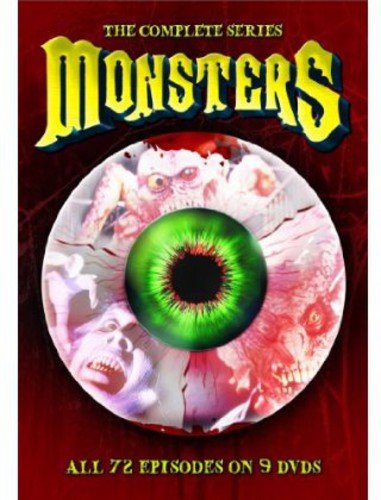
I’ve always been a fan of horror, suspense, thrills, and clever plot twists, but have always found it more satisfying when the focus is on the story and the characters rather than the special effects. Classic Hitchcock, The Twilight Zone, and Are You Afraid of the Dark? have long been favorites of mine. I still appreciated Tales From the Crypt even if it went more for literal shock factor and earning its R-rated equivalent presence on cable-only HBO. Somewhere in the middle of all that debuted a quiet little series called simply Monsters, running from 1988 to 1991. It’s replete with cringe-worthy dialogue, cheesy performances, and rubber suit monsters, prosthetics, and stop-motion animations that may be laughable by today’s standards, but these attributes are precisely what give it its charm and make it all the more worth watching.
Let’s face it — as good as The Twilight Zone is/was, there are definitely some moments where the dialogue or hammed-up acting make it kind of difficult to watch. Monsters is no different. From the stereotypical mild-mannered therapy-seeking Murray from “Murray’s Monster” to the sleazy businessman and introverted bookish beekeeping scientist at odds with one another in “New York Honey,” sometimes characters have to fit into generically typecast roles to get the audience to identify with them more quickly, as each episode only has 22 minutes in which to tell its story arc, execute character development, and deliver a redemptive twist. I can forgive that, as some of the stories and twists are really clever. Those that fall into the less-clever column are still fun to watch for their campy nature.
From one episode to the next, you’re liable to veer between writers and directors, giving some episodes a much different feel from the rest. “Jar” for example sports a weasley Richard Edson (better known as the garage attendant who joy rides in Cameron’s dad’s car in Ferris Bueller’s Day Off) and a sultry, gussied up Gina Gershon, both at odds with her gold-dug husband, all of whom are being secretly manipulated toward their individual demise by the proprietor of their shared quarters for the night (Fritz Weaver). Without giving much away, this was one tale that didn’t neatly fall in line with the redemptive twists common in many other episodes, so you never know quite what you’re going to get. “Jar,” “Bug House,” and “Love Hurts” were some of the darker episodes that spring to mind, whereas “Murray’s Monster” and “The Demons” are definitely at the campier, more humorous end of the spectrum. “The Feverman” and “The Vampire Hunter” whisk us away to a more Victorian time period, while some stories tackled weightier social issues, like “My Zombie Lover.” This story kicks off with a zombie-themed precursor to The Purge (one night a year, the dead rise and everyone hunts them for sport) that covers racial and gender and age prejudices, a smart take on the complications presented by awkward teenage sexual advances, and even a Romeo and Juliet styled tragic ending that suddenly takes a turn for the happily ever after. It was a weird episode and covered a lot of commentary in under a half hour.
The show attracted a bevy of talent from the era, some of whom were already stars (Tempestt Bledsoe, Meat Loaf, Adrienne Barbeau, Barbara Billingsley, Linda Blair, Darren McGavin, Richard Moll, Soupy Sales, Abe Vigoda, Richard Belzer, John Saxon, Laura Branigan, Mason Adams, Deborah Harry, Pam Grier) and more who grew into greater fame in the decade to follow (Wil Wheaton, Rob Morrow, Matt LeBlanc, Tori Spelling, Teresa Ganzel, Luis Guzmán, Tony Shalhoub, Kevin Nealon, David Spade, Lili Taylor, Steve Buscemi). Some held leading roles in their respective episodes — like Meat Loaf as Dr. Willard Wingite, who used a semi-animated corpse to harvest organs for his private practice — while others held more supporting roles — Teresa Ganzel played the bubbly receptionist to Joe Flaherty’s antagonistic, philandering, egotistical psychiatrist. In either case, they each play to their role, rather than stealing the spotlight, making the cameos that much more enjoyable. As much as I loved Darren McGavin as the affable dad in A Christmas Story, he definitely got creepy here in “Portrait of the Artist.”
The DVD box set spans all three seasons of the show, 72 episodes across nine discs. The picture quality looks to be about what it was 25 years ago when it aired, and natively displays at 1.33:1 aspect ratio (i.e., not widescreen) with 2.0 Dolby Digital audio. The grainy video quality compared to today’s HD adds a little aged character to the show, but also helps obscure some of the less developed special effects. HD snobs will not get excited over this transfer, but I thought it was perfectly fine. There aren’t any special features, subtitles, or other extras that I’m aware of — it’s literally just the episodes one after another.
Overall I’m glad I got to experience this show, since it’s the kind of thing that would appeal to a spooky story geek like me and I missed it when it originally aired. If you never saw it and enjoyed the other anthologies mentioned, or are interested in a time warp back to the late ’80s for a cheesy horror romp with the stars of yesteryear, I’d recommend you check it out, too.